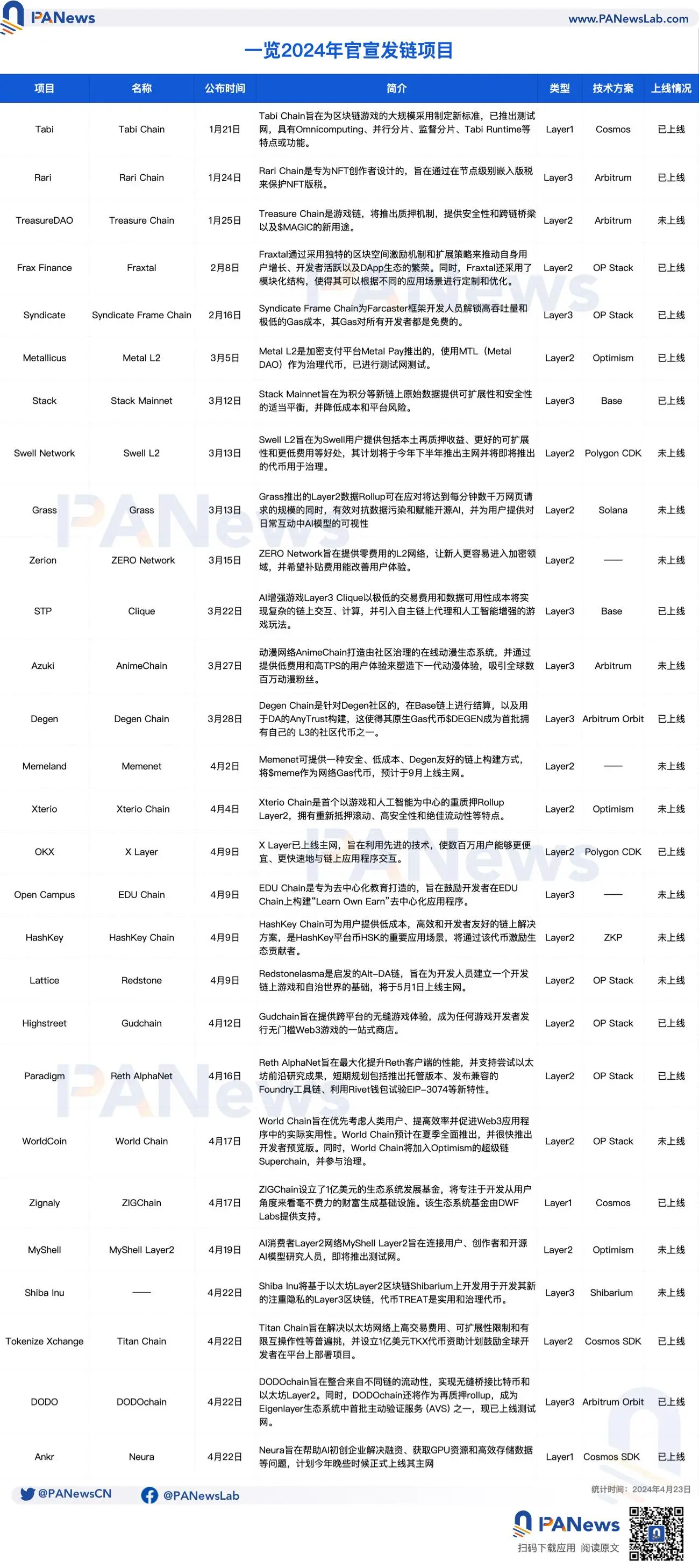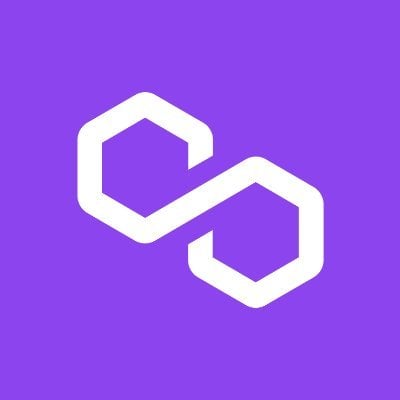Inventory of 28 officially announced chain projects in 2024: L2 and L3 become mainstream in the market, what are the "business strategies" behind the intensive chain releases?
Author: Nancy, PANews
As the deployment costs and development difficulties continue to decrease, launching chains seems to have become the "mainstream approach" for current crypto projects. This article by PANews reviews 28 crypto projects that have officially announced chain launches in 2024, organizing and analyzing the types of chains, launch situations, technical solutions, and impacts.

L2 and L3 Become Major Directions, Divided into General Chains and Application Chains
Compared to the past, which required strong technical capabilities, sufficient capital reserves, and a lot of time investment, many "one-click chain launch" tools like OP Stack, Arbitrum, Polygon CDK, and Zk Stack are driving the surge in chain launches. As the chain launch arms race begins, various players are entering the field to seize opportunities.
According to incomplete statistics from PANews, since the beginning of 2024, 28 crypto projects have joined the chain launch camp, coming from various sectors including gaming, NFTs, AI, DEPIN, exchanges, investment institutions, and wallets.
From a timeline perspective, 23 projects were announced in March and April of this year, accounting for as much as 82.1%. This indicates that the market's chain launch phenomenon mainly seizes the window period of a bull market and is increasingly becoming competitive; in terms of types, there are 25 chains in the market that are Layer 2 and Layer 3, with Layer 2 being particularly favored by projects, accounting for 57.1% of the total.
At the same time, regarding the launch situations and technical solutions of various chains, nearly half of the projects have already launched testnets or mainnets, with many expected to officially launch this year. Among the various development solutions, OP Stack, Arbitrum, Cosmos, and Polygon CDK are the mainstream adopted solutions, with 20 projects using these solutions.
Functionally, these chains can be roughly divided into two types: general chains and application chains. General chains are not limited to specific application scenarios and can support different types of businesses, including Fraxtal, Syndicate Frame Chain, ZERO Network, X Layer, and HashKey Chain, which each emphasize multiple advantages such as EVM equivalence, performance optimization, low fees, and incentive mechanisms.
For example, the crypto exchange OKX has built the X Layer based on Polygon CDK, which is a general chain aimed at enabling millions of users to interact with on-chain applications more cheaply and quickly, and it has already launched its mainnet. Since its launch on the testnet last November, X Layer has launched over 170 DApps and will soon introduce more applications; Frax Finance's Fraxtal is also a scalable general computing chain that promotes user growth, developer activity, and the prosperity of the DApp ecosystem through a unique block space incentive mechanism and expansion strategy, adopting a modular structure that can be customized and optimized for different application scenarios.
Application chains, on the other hand, are infrastructures tailored for different usage scenarios, particularly addressing issues such as performance, costs, throughput, and privacy that cannot meet the growth needs of high-frequency application scenarios. Typical representatives include Tabi Chain, Rari Chain, Treasure Chain, AnimeChain, Degen Chain, Memenet, and Neura, which are launched for fields such as gaming, NFTs, AI, and MEME.
For instance, the Web3 education platform Open Campus announced that its upcoming Layer 3 product, EDU Chain, is specifically designed for decentralized education, aiming to encourage developers to build "Learn Own Earn" decentralized applications on EDU Chain; the NFT project Memeland under 9GAG announced this month that it will launch the Layer 2 network Memenet, built for the MEME economy, which will provide a secure, low-cost, Degen-friendly way to build on-chain, expected to launch its mainnet in September; Tabi Chain is a blockchain designed for gaming and compatible with EVM, aiming to set new standards for the mass adoption of blockchain games, having launched its testnet with features such as Omnicomputing, parallel sharding, supervised sharding, and Tabi Runtime; Gudchain is a custom chain developed by the metaverse platform Highstreet specifically for game development, aiming to create an interoperable metaverse that provides a seamless gaming experience across platforms and becomes a one-stop shop for any game developer to launch Web3 games without barriers, with its first Fair Launch and support for staking $HIGH coming soon.
Of course, as OP Stack and Arbitrum launch more efficient chain launch tools and continue to promote open-source plans, the competition among multiple chains is bound to intensify, and outdated chains will be eliminated by new chains with more market competitiveness.
Multi-faceted Empowerment Under the Chain Launch Narrative
For various projects, launching chains has different degrees of promoting effects on expanding their narrative power, breaking business bottlenecks caused by performance issues, and enhancing brand value and influence.
On one hand, launching chains has become a "traffic code" for business expansion, asset activation, user acquisition, and even brand transformation and upgrading. Taking the stablecoin protocol Frax Finance as an example, due to the limited market competitiveness of its stablecoin business, the project began exploring a multi-product suite, including the modular Layer 2 blockchain Fraxtal built on OP Stack launched in February this year, which promotes user growth, developer activity, and the prosperity of the DApp ecosystem through a unique block space incentive mechanism and expansion strategy; similarly, the blue-chip NFT project Azuki, after a series of NFT crashes and fluctuating reputation, launched the anime network AnimeChain based on Arbitrum in late March this year in collaboration with Arbitrum Foundation and Weeb3 Foundation to create a community-governed online anime ecosystem, shaping the next generation of anime experiences by providing low fees and high TPS to attract millions of anime fans worldwide.
On the other hand, due to performance limitations, high on-chain costs, and other issues leading to poor user experience and expansion limitations, many projects are leveraging chain launches to achieve a better and smoother user experience and lay a better foundation for ecological growth and prosperity, such as Treasure Chain, World Chain, Syndicate Frame Chain, Stack Mainnet, Grass, Clique, Reth AlphaNet, and Titan Chain. For example, the crypto project Worldcoin, founded by Sam Altman, has built the Ethereum Layer 2 network World Chain based on OP Stack. Since its launch, Worldcoin has seen rapid user growth, with its user base exceeding 10 million, but it faces congestion issues due to bot activity, and the current L1 and L2 solutions are difficult to improve network inefficiencies and high costs in the short term. The launch of World Chain can integrate bot scrutiny into its DNA while significantly increasing capacity and maintaining low-cost advantages, additionally supporting interactions with other super chain members, thereby aiding its vision of "bringing billions of users into the crypto market."
Moreover, many projects have also seen a certain boost in project value and influence after launching chains, such as Swell L2, Shiba Inu, ZIGChain, and Grass. For instance, the yet-to-launch token Swell Network announced in March this year the launch of the Layer 2 rollup project Swell L2 based on Polygon CDK, which plans to go live in the second half of this year and will use the upcoming token for governance. At the same time, Swell has opened the Pre-Launch deposit entry for the L2 network, allowing users to deposit ETH and various LSTs and LRTs to gain multiple potential benefits, including Swell's own tokens and airdrop rewards from major projects on Swell Layer 2. As a result, Swell Network has demonstrated strong capital attraction in the short term, with total deposits in its L2 exceeding $300 million just half a month after its launch, indicating the market's value imagination for Swell Network; similarly, the DePIN project Grass, which has not yet launched its token, also launched a Layer 2 data rollup based on Solana in March this year, effectively combating data pollution and empowering open-source AI while providing users with visibility into AI models in daily interactions, with recent information from Grass community contributor conte showing that Grass still has 1.8 million real users after excluding 7.5 million fake accounts.
Overall, "plug-and-play" chain launch tools have enhanced the convenience and feasibility of public chain development, which can to some extent promote the emergence of more innovative use cases and bring about ecological prosperity.
However, the influx of too many participants can easily lead to aesthetic fatigue in the market, causing truly high-quality projects to be overlooked. If the market focuses on the chain launch narrative and "reinvents the wheel," it will greatly disperse market liquidity, exacerbating the phenomenon of public chains "idling" without ecology and users. After all, the premise of having enough "roads" is having enough "vehicles" to use them.















